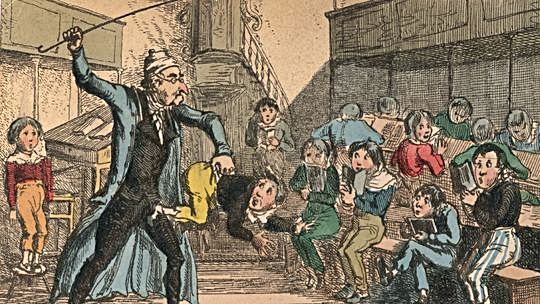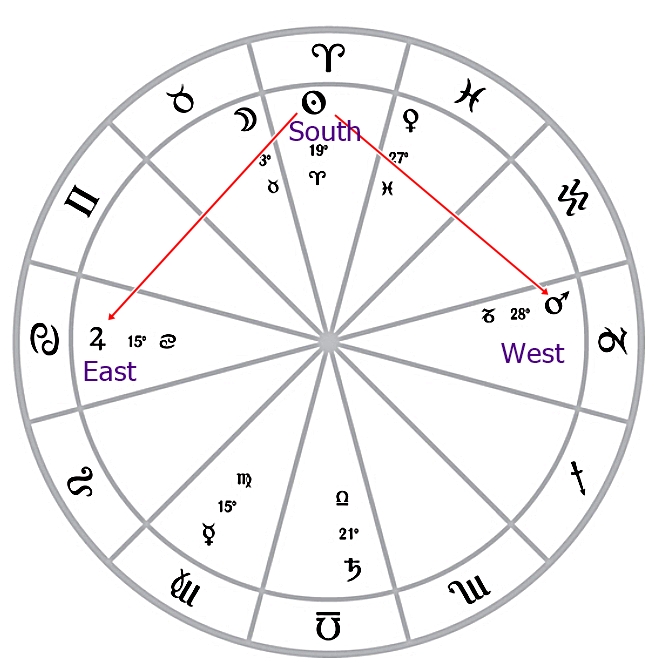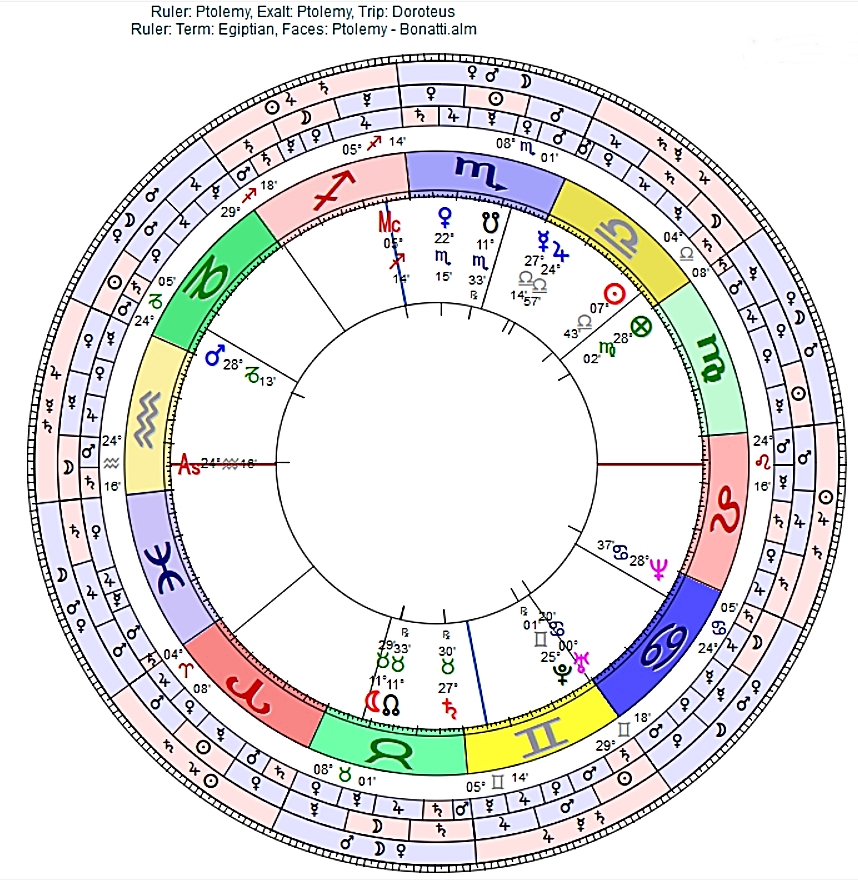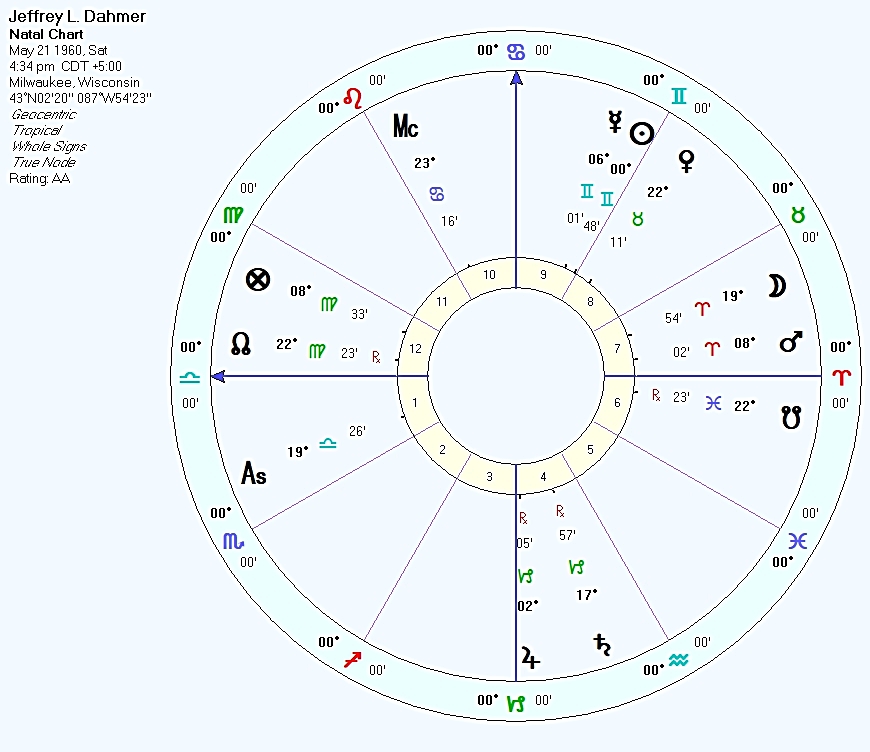A reader of my book on horary astrology recently wrote to me, asking a question about dexter and sinister aspects in astrology. Lilly had written, “Observe the dexter aspect is more forcible than the Sinister” (CA 109). When I first read this statement back in the 1980s, it reminded me of the nuns punishing my classmates in grammar school for being left-handed. Being right-handed myself, I was spared the vengeance of the Sisters of Mercy. Apparently their belief was that the good angel sat on the right (dexter) shoulder whereas the devil (sinister) sat on the left one. And, after all, Jesus sat on the right side of God and not to the left of the deity. Even the English language carries this bias. “Dexterity” refers to skillfulness or adroitness, but “sinister” means ominous, disquieting or threatening.

The schoolmaster holds the rod in his right hand (dexter) and grasps the unfortunate student with his left (sinister).
Yet the idea of dexter and sinister aspects in astrology does not have to do with religious beliefs but rather with an ancient philosophical notion, probably Pythagorean, based on observation of the apparent movement of the heavens.
Ancient astrologers observed that each day the Sun rises in the east, culminates at the Midheaven and then sets in the west. This obvious and easily witnessed movement of the Sun across the sky was called “primary motion.” At night as the stars appeared, they also rose in the east, culminated at the MC, and set in the west, again following the primary motion of the heavens around the observer on Earth. This daily and obvious movement of the Sun and stars across the sky was considered fundamental and primary, hence the name “primary motion.” All heavenly bodies and the signs of the zodiac followed this pattern.
Looking more closely over long periods of time, the ancients noticed that a tiny group of “stars” seemed to “wander” and these wanderers were called in English “planets” from the Greek word planētēs ‘wanderer, planet’, from planan ‘wander’. The odd thing about these wanderers is that even though they followed primary motion across the sky every day, they also appeared to have a “secondary motion” in the opposite direction, that is from west toward east, in contrast to their daily “primary motion” from east toward west. This secondary motion appeared to be unique and fundamental to this small group of celestial objects, called planets or wanderers.
Our astrology developed in regions on Earth which lay north of the ecliptic circle so that astrologers had to look to the south to observe the movement of planets along the ecliptic. As a result, we tend to draw our horoscope charts as wheels with the Ascendant or eastern horizon on the left, the MC to the south, and the western horizon or Descendant on the right.
If we picture ourselves standing at the center of a horoscope wheel and looking at the MC, the natural primary motion of the sky flows from the Ascendant at our left in the east, in a rightward or clockwise direction up to the MC in the south, and continuing rightward or clockwise toward the western horizon in the west. Thus, the natural flow, or the primary motion, has sense of being “dexter” or toward the right-hand side of the observer. Aspects cast in this dexter or clockwise direction with respect to the observer at the center of the wheel are therefore considered more natural, fundamental, and in the normal flow of things. That’s just how the whole sky moves. Being in tune with nature and “going with the flow,” dexter aspects were considered, as Lilly said, more forcible.
It is important to remember that aspects were originally described in terms of the signs of the zodiac rather than the planets. Thus, the idea of dexter and sinister aspect must be viewed as a property of whole sign aspects that was later applied to planetary aspects.
The sinister aspects are simply aspects cast by a planet toward the left-hand side of the observer looking at the planet from the middle of the wheel. Movement toward the left is in the counterclockwise direction of “secondary motion,” which is unique to the small group planets. Secondary motion, and sinister aspects which are related to this concept, are an oddity and a bit unnatural because only seven visible celestial object (Sun, Moon, and five visible planets) exhibit secondary motion to the naked eye. They are like fish swimming again a powerful current. Being unnatural and attempting to move against the flow of the entire sky, sinister aspects were considered less forcible than dexter ones.
In other words, a planet casts its dexter aspects in the direction of the flow of the heavens around the earth, and its sinister aspects against the flow or in the opposite direction of the primary motion of the heavens around the earth, as viewed by an observer on earth.
A dexter aspect has not only the force of the planet behind it but also the force of the movement of the entire heavens around the Earth, so it is considered to be more powerful than the sinister aspect. Aspects are metaphors for seeing or casting one’s gaze (planetary rays), so it is not surprising that Hellenistic authors sometimes refer to these dexter aspects as the “hurling of rays” [“hurl” means “to throw with great force”] backward in the zodiac in the direction of primary motion with the tremendous combined force of both their originating planet and the entire sky, whereas the weaker sinister aspects, which must travel against the natural daily flow of the heavens, are simply looking forward in the direction of secondary motion to the planets ahead of them in the zodiac. The Hellenistic concept of “hurling,” or casting with great force, may be the origin of William Lilly’s statement: “Observe the dexter aspect is more forcible than the Sinister” (CA 109).

Original Image from https://commons.wikimedia.org/wiki/File:Exaltation_Degrees_of_the_Planets.jpg
Because dexter aspects are cast in the direction of the diurnal flow of the heavens as viewed by an observer on Earth, they were considered to be more natural, direct, uncomplicated, powerful and effective. Sinister aspects, on the other hand, were cast against the flow of the heavens and were thus considered less natural, less direct and less effective. A motorboat can travel more effectively and efficiently downstream, with the current of a river, than upstream and against the water’s flow.
In her article about aspects on skyscript, Deborah Houlding summarizes the distinction between dexter and sinister as follows:
“A dexter aspect is therefore more direct. Because the line of sight is carried by diurnal motion it has a stronger influence than a sinister one and is more likely to produce an uncomplicated, expressive effect. A sinister aspect, because it is issued against the natural movement of heaven and has to ‘look backwards’, is weaker, distorted, inverted or somewhat debilitated.”
The concept of dexter and sinister aspects is not to be confused with the notion of the dominating, prevailing or overpowering planet of a square aspect, which is found in the works of Dorotheus, Valens, Porphyry and other Hellenistic authors. Comparing the strength of planets to the strength of aspects is like comparing apples and oranges. For example, one contemporary author makes the confusing statement that “right-sided [dexter] aspects were considered more powerful because they rise and culminate before the planets that they aspect on their left,” in other words, this statement is saying that a dexter aspect is more powerful than the planet which the dexter aspect itself aspects. This makes no sense because aspects are not planets, and the dexter aspect of a planet does not act like a another planet that sends its own rays back to the planet which it came from.
Suppose that planets A and B are 90 degrees apart, forming a square aspect. Then, if B is 90 degrees to the right of A, as viewed by an observer on Earth (or from the center of a horoscope wheel), the B dominates or overpowers A. The reasoning for this dominance appears to be that in such a case, the planet B bears a 10th house or culminating, and therefore much more regal, powerful or prevailing, position with respect to A. One might view this in terms of a derived chart in which planet A becomes the turned Ascendant, which places planet B ten houses (whole signs) away in the 10th house, which symbolizes rulers and monarchs, so that B dominates or overpowers A.

In Porphyry’s view, “overcoming,” “prevailing” or “dominating” appears to be related to a planet’s secondary motion, in contrast to the dexter/sinister aspect distinction which is related to the primary motion of the signs of the zodiac.
Porphyry writes about which planet predominates or prevails in trine, square and sextile aspects:
“Every star [planet] prevails when it is posited in a dexter trine or square or sextile to one on its left, for that one goes toward it [in secondary motion]. For example, one that is in Capricorn prevails over one in trine aspect in Taurus […] They say that prevailing is more powerful when [the planets] are in trine or square. For the prevailing star is thus stronger […]” (Porphyry, Holden trans., 2009, Ch. 21, p. 17)
For example, in the horoscope wheel above, Mars in Capricorn is in a whole sign trine to the Moon in Taurus. Mars lies to the right of the Moon and by secondary motion Mars is moving toward the Moon’s position in the chart because Mars is traveling direct rather than retrograde. The Moon is casting its dexter trine into Capricorn, and Mars is casting its sinister trine into Taurus. By Porphyry’s definition, Mars will prevail over the Moon.
Porphyry also writes: “Each star [planet] sends forth seven rays, three upwards and three downwards, and one towards the diameter, of which the upward ones are on the right side, but the downward ones are on the left side.” Here Porphyry is imagining that the planet under discussion is lying on the eastern horizon and sending its dexter sextile, square and trine upwards toward the MC, sending its sinister sextile, square and trine downward toward the IC, and sending its opposition aspect directly across the chart to the Descendant. The dexter aspects are sent in the direction of primary motion, which is the natural daily flow of the heavens, and are therefore more in tune with nature and more powerful. The planets which receive the dexter aspects from the planet on the eastern horizon are in a superior position with respect to the sending planet and is therefore in a dominant or prevailing position in the aspect configuration.
We can contrast Porphyry’s ideas about one planet prevailing over another with the statement by Manilius in his Astronomica about how the signs look at each other:
“Capricorn views Libra, whilst the Ram sees Capricorn ahead and is in turn beheld at an equal distance by the Crab, and the Crab is perceived by Libra’s leftward stars as it follows up: for preceding signs are reckoned as right signs.” (Astronomica, 2.290-295; Loeb edition, p.105).
Here Manilius is saying that the sign Capricorn looks to its right at the sign Libra, which precedes it in the zodiac. Similarly, Aries naturally looks to its right (in the direction of primary motion) toward Capricorn, which appears on the eastern horizon before it. And Libra looks to its right toward Cancer, which rises before Libra does in the east. Because of primary motion, the natural direction of gaze of a sign is toward the right, that is, toward the signs which have risen before it in the course of the day. The ancients called the Ascendant the “Helm” which steered the ship, and the natural direction of gaze from the helm is in the direction of primary motion (clockwise, to the right in the typical Western horoscope wheel) because that is where the ship is headed.
The Hellenistic astrologers appeared to pay more attention to which planet prevailed in an aspectual relationship, as determined by which planet was to the right of the other in the configuration of that aspect. Lilly appears to have focused more on the idea of a dexter aspect being more forcible than a sinister one, perhaps because he was unfamiliar with the Hellenistic notion of one planet prevailing over or dominating another by being to its right-hand side in an aspect.
Dorotheus gives the following example in Carmen Astrologicum, Bk. II.15.14, p.215:
Suppose that Mars and Jupiter are in square asepct. Then, if Jupiter prevails over Mars by lying to the right of Mars, then the native will be noble, steadfast and compassionate; here Mars casts its forcible dexter square to Jupiter. Perhaps the reasoning is that Jupiter is able to absorb the powerful force of Mars and direct it toward nobility.
But if Mars dominates Jupiter by lying to the right side of Jupiter in the aspect, then the natvie will be feeble-mined, tiresome, fatigued and slanderous; in this case, Jupiter casts its forcible dexter aspect to Mars. Perhaps in this case Mars absorbs the powerful expansiveness of Jupiter, and being a malefic planet, utilizes Jupiter’s energy toward nefarious ends.
An Example Chart
Rhetorius discusses the chart of the poet Pamprepius who was also a deceitful, self-serving and traitorous politician. Here is my approximation of the version of the chart used by Rhetorius, recast in the tropical zodiac.

In his commentary Rhetorius discusses Mars in the whole sign 12th Place squaring a peregrine Mercury in the whole sign 9th. Firmicus Maternus describes this aspect as follows: “If Mercury is elevated and, possessing the right side, aspects by square Mars posited in a lower place, that configuration will make evil, malign and malicious persons, always armed by a very bad and pestiferous greediness of mind, exercising all the actions of deceit …”
Note that Mars “hurls” its harmful rays by a powerful dexter square to peregrine Mercury, which is “more elevated” than Mars and thus prevails in this configuration. Thus, the harsh significations of Mars, the out-of-sect malefic occupying the troublesome 12th Place, are hurled to Mercury, damaging this planet of the mind and manifesting as “greediness of mind, exercising all the actions of deceit” etc. In other words, by means of its forcible dexter aspect, Mars imbues Mercury with a strong dose of its Mars-like maleficence, which Mercury, as the prevailing planet, puts to use in devious and deceitful mental and Mercurial ways.
Another Example: Jeffrey Dahmer

As another example let’s consider the chart of Jeffrey Dahmer, the serial killer who ate his victims. He has Moon and Mars in Aries in the 7th Place squaring by whole sign Jupiter and Saturn in Capricorn in the 4th Place. One would expect the fallen Jupiter and the Saturn in its domicile to characterize his domestic life and early home environment. Saturn also rules the 5th Place of romance.
Moon and Mars cast their forcible dexter squares from Aries into Capricorn. Jupiter and Saturn “overcome” Moon and Mars by whole sign aspect. The implication would be that the domestic life, romances, and the 3rd and 6th Places ruled by Jupiter would be strongly influenced by the significations of Moon and Mars in Aries in the 7th, which would be expressed through the dominant planets Jupiter and Saturn, which incorporate Moon & Mars in Aries in the 7th into their expression and manifestation in the world.
For example, Mars as out-of-sect malefic is angular in the 7th and in domicile, so its dexter aspect will be quite strong and malefic. Saturn, dignified in Capricorn, incorporates the powerful malefic Mars influence and manifests it in his domestic and romantic life. He easily attracts lovers into his home where he kills and eats them. Perhaps we could view Moon in Aries in the 7th as signifying aggressive eating in one-to-one relationships which gets incorporated into the expression of Jupiter and Saturn in the 4th, which dominate the Moon.
If we were to turn Dahmer’s chart so that Moon & Mars were in the 1st Place, then Jupiter and Saturn would be in the 10th Place of praxis or action in the world.
If you have seen the movie Invasion of the Body Snatchers, an analogy might be that the dominating or overcoming planet is like the alien Pod which absorbs all the traits of the human whose body it snatches. The Pod is like the overcoming planet, and the human who is being absorbed is like the dexter aspect sending its significations (human traits) to the overcoming planet (the alien Pod).

This has always puzzled me: If planets naturally move in a sinister direction, i,e,. from Capricorn to Aquarius or from Aries to Taurus, then why is retrograde motion believed to be a less favorable action, as in retrograde, a planet moves in a dexter direction? One would think that the planets would generally e considered “naughty”, but that they were at least temporarily trying to mend their ways while retrograde, yes? 🙂
Good question. I added a couple quotes and further explanation to the end of the post, which may help answer your question. It appears that the early astrologers distinguished two types of motion: primary and secondary. Primary motion was a property of the entire sky, and thus of the signs of the zodiac. Everything in the sky rises, culminates and sets on a daily basis. This motion is primary and fundamental.
At the same time there is a small group of objects which, by their natures, move in the opposite direction. These are the Lights and the planets. When planets move retrograde, they are basically moving in the direction of primary motion, which is against their fundamental natures as wanderers among the fixed stars, which always travel in the direction of primary motion, at least as far as the human eye can see during a human lifetime.